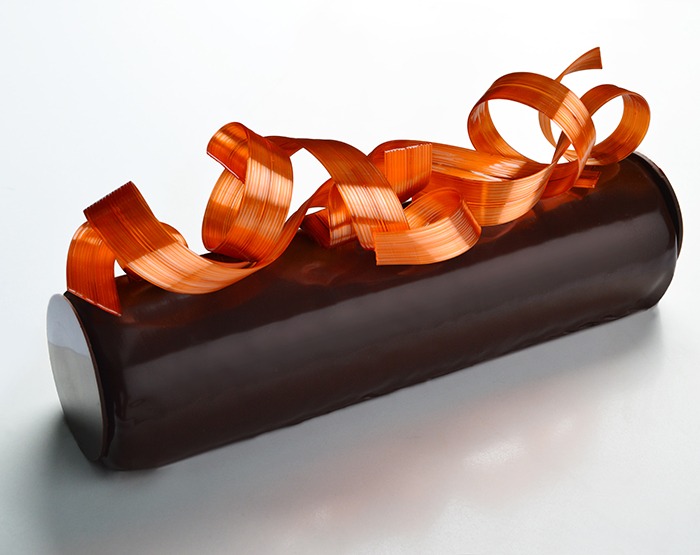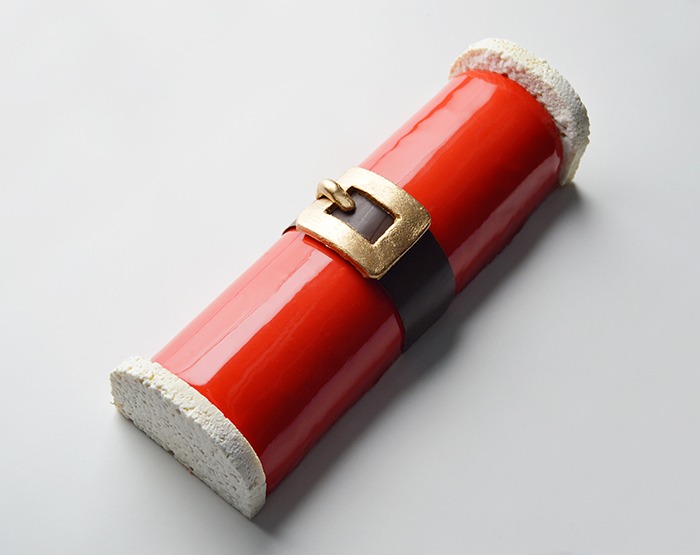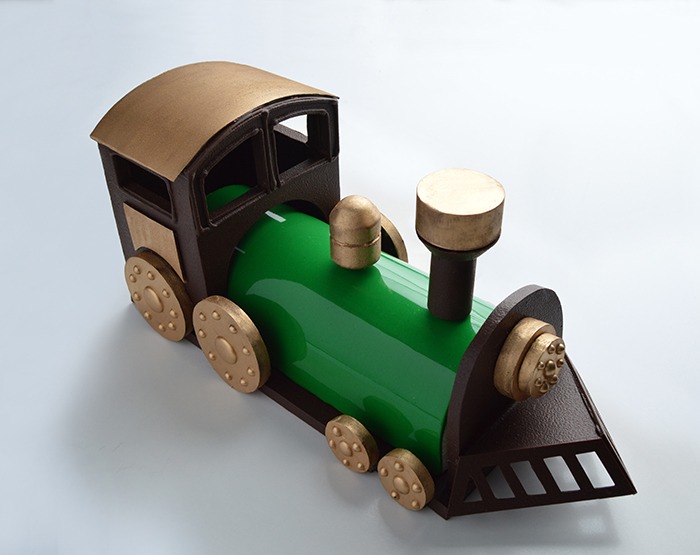Each holiday brings with it a unique set of traditions, and food invariably plays a significant role in these celebratory customs. Depending on your family’s cultural background, a delightful collision of various traditions and flavors may unfold. Starting today and running until January 6, we’ll be showcasing desserts that are popular in various countries throughout the week bridging Christmas and New Year’s.
Italians traditionally prepare an array of dishes, featuring the Feast of the Seven Fishes, pasta, tortellini in brodo, and panettone. In the United Kingdom, tables are adorned with turkey, goose, Yorkshire pudding, mince pies, and other festive treats. The French indulge in oysters, escargot, scallops, foie gras, and an assortment of desserts, including the iconic Bûche de Noël.
The History of the Bûche de Noël
Even though this dessert is typically served during Christmas – Noël is in the desserts name – the French also will serve it throughout the week leading up to the New Year.
The Bûche de Noël, also known as Yule log, is a traditional French dessert that has become synonymous with Christmas and now New Year celebrations. The origin of the Bûche de Noël can be traced back to Yule, a monthlong winter solstice celebration observed by the Germanic tribes of Northern Europe. Its origins can be traced back to medieval times when families would gather and burn large wooden logs during the winter solstice to symbolize the coming of longer days and the return of warmth and light.
“The first recorded mention of the buche de Noel appeared in 1898, in Le Memorial Historique et Geographique de la Patisserie, a cookbook by the Parisian pastry chef Pierre Lacam,” writes Gabriella Gershenson for “Saveur.”
The culinary evolution of the Bûche de Noël can be linked to 19th-century Parisian pastry chefs who sought to create a festive and visually appealing dessert for Christmas celebrations. The tradition of burning an actual log was gradually replaced by a sweet, edible representation in the form of a rolled sponge cake.
The cake itself is a light and fluffy génoise, a type of sponge cake, which is baked in a thin layer and then rolled into a log shape while still warm. This roll is then filled with various delicious fillings such as buttercream, ganache, or flavored whipped cream. The outer layer is often coated with chocolate ganache, frosting, or a chocolate buttercream to resemble the bark of a tree.
The Bûche de Noël is typically decorated to mimic the natural elements found in a forest, such as mushrooms made from meringue, marzipan leaves, or powdered sugar to represent snow. The finishing touches often include festive decorations like holly leaves, berries, and sometimes even a dusting of edible gold or silver.
Over time, the Bûche de Noël has become a beloved and cherished dessert not only in France but also in many other countries around the world. Its popularity has grown, and pastry chefs often showcase their creativity by experimenting with various flavors, fillings, and decorations while still adhering to the traditional log shape.
Today, the Bûche de Noël is an essential part of Christmas and New Year’s celebrations, and it continues to be enjoyed by families throughout the holiday season. The dessert has transcended its French origins and has become a symbol of joy, festivity, and delicious indulgence during the most wonderful time of the year.



As previously noted, the Bûche de Noël traditionally took the form of a log. Nevertheless, chefs nowadays craft them in a variety of shapes, often opting for sculptural or modern designs.
The following recipe was created by Chef Scott Green, who was a member of the 2015 Club Coupe du Monde Team USA. He, along with team members Chefs Josh Johnson and John Kraus and coaches Chef Donald Wressell and Ewald Notter, won the bronze medal at the Coupe du Monde de la Pâtisserie in Lyon, France.
This recipe will be using a joconde. According to Scott, this is a “somewhat dry and often thin sponge cake made of whipped eggs and meringue. If I’m being real, joconde by itself isn’t very good. That’s because it’s really meant to be a component in a full dessert, where the sum is greater than its parts.”
“Once you roll the joconde up with some frosting, or throw it in an entremet, it’s awesome,” says Green. “One little trick to making a joconde is being careful with the foams you create (the whipped eggs and meringue) until the very end of the process, and then giving the batter a little roughing up to deflate it just slightly. Doing this helps to avoid large holes in the bake.
You’ll also want to bake the joconde until 95% finished, letting carry-over cooking take care of the last 5%. Because we’re going to roll this cake up, it’s super important that it has flexibility and any over-baking will ruin that ability.”
Bûche de Noël
Chocolate Joconde
| Ingredients | Measurement |
| Pastry flour | 90g |
| Almond flour | 90g |
| Confectioners’ Sugar | 112g |
| Whole eggs (room temperature) | 93g |
| Egg yolks (room temperature) | 60g |
| Egg whites (room temperature) | 206g |
| Granulated sugar | 75g |
| Cocoa powder (We use Valrhona) | 22g |
Buttercream
| Ingredients | Measurement |
| Eggs, large (room temperature) | 100g |
| Egg yolks (room temperature) | 40g |
| Granulated sugar | 160g |
| Water | 50g |
| Corn syrup (glucose) | 10g |
| Egg whites | 206g |
| Butter, unsalted (room temperature) | 500g |
| Salt | 1g |
| Whisky, bourbon, Grand Marnier, Amaretto or any other spirit of your choice (OPTIONAL) | 1-2 Tbsp |
Chocolate Ganache
| Ingredients | Measurement |
| Dark chocolate 58% (Valrhona Oriado [60%] or Equatorial [55%]) | 210g |
| Milk chocolate 41% (Valrhona Jivara [40%]) | 45g |
| Confectioners’ Sugar | 112g |
| Corn syrup (glucose) | 78g |
| Heavy cream | 315g |
| Butter, unsalted | 105g |
| Salt | 2g |
Chocolate Glaze
| Ingredients | Measurement |
| Granulated sugar | 142g |
| Water | 180g |
| Corn syrup (glucose) | 161g |
| Sweetened condensed milk | 112g |
| Gelatin | 14g |
| Dark chocolate 72% (Valrhona Araguani) | 206g |
| Valrhona cocoa powder | 8g |
Instructions
Chocolate Joconde
Bring the egg whites to room temperature before starting.
Combine the almond flour, powdered sugar, whole eggs and egg yolks and whisk them in a stand mixer with a whip attachment until it thickens and lightens to the ribbon stage.

Whisk the egg whites with half of the sugar in a stand mixer with a whip attachment. Whisk on medium speed until the egg whites completely foam with no clear albumen showing.
Add the second half of the sugar and increase the whisking speed to high, whipping until the meringue is stiff.

Fold the meringue into the whipped egg mixture.


Add the sifted pastry flour and cocoa powder and fold into the batter until incorporated.


Add 600g of batter per half-sheet pan, keeping in mind the recipe makes more than that to account for some product loss. You can either bake on a non-stick baking mat or parchment paper, however, just be sure to seal the paper to the sheet pan with pan spray or a thin layer of butter.


Bake the joconde at 375F/190C for 7min.

Once the jaconde comes out of the oven and is cool enough to touch, but still warm to hot (be careful – it will cook quickly) lay a clean dishtowel down flat or a large piece of parchment paper. Remove the jaconde from the pan and flip it upside down on top of the towel or parchment. It should not stick later when you unroll it, but if you want a little insurance you can lightly sprinkle cocoa powder on the towel or parchment paper before turning out the jaconde. Carefully peel off the Silpat or parchment paper from the bottom. Tightly roll up the warm jaconde around the towel with the seam side down when finished. Set aside.
This step does a couple of things:
1 – It makes it easier to roll up the jaconde later when you spread the buttercream on
2 – It will prevent the cake from cracking or ripping when you start assembling the yüle log.
Buttercream
Bring the butter to room temperature before getting started.
Combine the sugar, water and glucose and bring it to a boil in a saucepot, cooking the syrup to 244F/118C.
While the syrup is cooking, combine and whisk the whole eggs and egg yolks in a stand mixer on medium speed with a whip attachment.
When the syrup reaches temperature, pour it over the egg mixture on high speed. Be careful not to pour the syrup over the spinning whip attachment or it will fling the sugar everywhere but the eggs. If your pot has a lip on it, hook it onto the lip of the mixing bowl and pour the hot sugar syrup down the inside of the mixing bowl.
After adding all of the sugar syrup, continue to whisk on high speed for 30 seconds and then reduce the whipping speed to medium.
Let the mixture whip until it cools to just above room temperature and thickens.
Note: You can also add whiskey, bourbon, Irish cream, amaretto, Grand Mariner, or any other spirit you like to the buttercream.

Add the butter to the mixture until it is fully incorporated.

Chocolate Ganache
Combine the glucose and heavy cream in a sauce pot and bring it to a simmer.
Pour the hot cream mixture over the chocolates, giving the holding vessel a little shake to allow the cream to cover the chocolate.

Let sit for 2min. and whisk or hand blend until emulsified.
Add the butter and salt and whisk or hand blend again until emulsified.


In the photo above, the speed of the blades aerated the ganache slightly which you can see by the air bubbles on the surface. Not the end of the world, but you want to try and avoid aerating your ganache whenever possible to keep the texture dense and creamy.
The best way (and Scott’s favorite way) to quickly cool the ganache is to place plastic wrap onto a sheet pan and then pour and spread the ganache over the plastic wrap. Add a second piece of plastic wrap on top of the ganache, touching the surface to keep it from drying out and forming a skin. The increased surface area will allow the ganache to cool quickly in the fridge. It took just 5-8min.

Again, all those air bubbles are bad news.

Chocolate Glaze
Hydrate the gelatin in cold water and reserve.
Combine the sugar, water, glucose and sweetened condensed milk and bring to a boil.
Cook the syrup to 221F/105C.

Squeeze out excess water from the hydrated gelatin and add it with the chocolate and cocoa powder to the syrup.


Whisk or hand blend until homogenized.
Chocolate Bark
Before getting started you will need a piece of acetate or parchment paper and an offset spatula. If you have both acetate and a sheet of plexiglass, seal the acetate to the plexiglass using a small amount of water and a dough scraper as a squeegee to create a seal.
Temper your chocolate (here’s a reminder on that process).
Spread a thin, even layer of chocolate over the acetate/parchment.


Let the chocolate start to set up, become thicker in viscosity and using the tip of your offset, create an uneven texture to imitate the texture of bark.

If you’re using acetate/plexiglass, let the chocolate set before using. If you’re using parchment paper or acetate without plexiglass, let the chocolate set until the surface is mat instead of glossy, then place a second piece of parchment paper over the chocolate follow by an even weight. A few flat sheet pans or a large coffee table book works well. This will prevent the chocolate from curling while it sets and contracts. If you’d like the chocolate to curl, don’t do a damn thing, which is precisely what I did.

After the chocolate sets, I like to break it into shards to use as bark. Looks fancy, super easy to do.

Pour the leftover tempered chocolate onto a second piece of parchment, chunks of chocolate and all. Once it was set, cut two pieces out to serve as end caps to the Yule log. If you aren’t sure how large the ends of the Yule log are, just cut the pieces a little larger than necessary and trim them to fit.
Assembly
To make chocolate buttercream, combine the buttercream with the chocolate ganache in a 2:1 ratio of buttercream to ganache.



Remove the baked joconde from the non-stick baking mat and clean the edges with a knife. Place the joconde on parchment paper. Make sure the crust of the joconde is either gently rubbed off or facing up, or it will stick to the parchment paper and make rolling difficult.
Spread a thin layer of ganache (approx: 150g) over the joconde.


Cover the layer of ganache with a thin layer of chocolate buttercream (200g).


Begin to roll the joconde, making sure the initial curl of the cake is tight. If the cake cracks or rips during this tight roll, don’t worry! Continue to roll the joconde up, keeping the roll nice and tight.
Now roll the plastic wrap around the roll, and tighten by twisting the plastic wrap on either end in opposite directions, like a hard candy wrapper.



Freeze the roll and unwrap.
Cover the roll with buttercream. The easiest way is to pipe an even layer all over the top. It is quick and efficient. Then, remove the excess buttercream with an offset spatula, either to smooth it or add a texture. Chef’s choice!


After lightly smoothing the buttercream with an offset spatula you have some perfectly acceptable bark texture going on. You could stop here and we wouldn’t tell anyone.

Use a thin and flexible dough scraper to match the contour of the log and get a smoother finish to the buttercream before freezing it.
Place the frosted log back in the freezer for a minimum of 20min.
Prepare your chocolate glaze by warming it to 84F/29C. Create a glazing rack by covering a sheet pan with plastic wrap and placing a glazing/cooling rack on top.
Place the frozen roll onto the glazing rack and glaze with the chocolate glaze. Pour in a high stream to eliminate air bubbles. Pour the glaze down the center of the log in an even stream and pace from one end to the other in one pass. Don’t be afraid to be generous with the glaze, you’ll catch excess on the plastic wrap to use again if you’d like. Place the setup in the fridge for 10 minutes. to allow the glaze to set.

Trim the ends of the Bûche de Noël and transfer it from the glazing rack to a serving platter.
Traditionally, the Bûche is finished with a chocolate buttercream streaked to look like the bark of a tree and covered in meringue-shaped mushrooms. However, this one is covered in chocolate ganache and decorated with chocolate bark.
Other decorations include marzipan holly leaves, sugared cranberries, and a dusting of confectioners’ sugar – to resemble snow. Of course, you can decorate your Buche de Noel with anything your heart desires!


This is a perfect cake to ring in the new year with a glass of champagne. Happy New Year!
Images: Scott Green website
